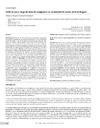Identificador persistente para citar o vincular este elemento:
https://accedacris.ulpgc.es/handle/10553/70214
| Campo DC | Valor | idioma |
|---|---|---|
| dc.contributor.author | Vallejos Narváez, Álvaro | en_US |
| dc.contributor.author | Ruano-Rodríguez, C. | en_US |
| dc.contributor.author | Latorre Morasso, Salvador | en_US |
| dc.contributor.author | Calvache, J | en_US |
| dc.date.accessioned | 2020-02-09T21:28:35Z | - |
| dc.date.available | 2020-02-09T21:28:35Z | - |
| dc.date.issued | 2015 | en_US |
| dc.identifier.issn | 0122-0667 | en_US |
| dc.identifier.other | Dialnet | - |
| dc.identifier.uri | https://accedacris.ulpgc.es/handle/10553/70214 | - |
| dc.description.abstract | El dolor es uno de los síntomas más frecuentes e importantes en el paciente hospitalizado, con una frecuencia hasta de 76.9%. El adecuado control del mismo es uno de los objetivos terapéuticos más buscados. Para lograr este objetivo, frecuentemente suelen usarse dosis inadecuadas de analgésicos, lo cual ocasiona reacciones adversas en los pacientes. El objetivo de este trabajo fue identificar los analgésicos de mayor uso en el paciente adulto hospitalizado y el rango de dosis de los mismos en un hospital de cuarto nivel de la ciudad de Bogotá. | en_US |
| dc.description.abstract | Pain is one of the most common and important symptoms inpatients, with a frequency of up to 76.9%. Proper control of the same is one of the most sought therapeutic targets. To achieve this goal, often inadequate doses of analgesics used, which causes adverse reactions in patients. The aim of this study was to identify the most widely used analgesics adult inpatient and the dose range of them at a hospital in fourth level of Bogota. Methods: Descriptive observational cross-sectional study inpatients over 18 years with prescription painkillers, selected by stratified random sampling according to service, from July to December 2013. Painkillers and prescribed doses were evaluated and compared with the maximum daily doses described for each one. The analysis of the sociodemographic and pharmacological variables was performed using STATA 12, Results: Medical records of 355 patients were evaluated, finding 555 prescription painkillers. The most used were acetaminophen in 186 cases (33.5%) and tramadol 167 (30.1%). The use of tramadol and acetaminophen was found an appropriate range of doses in 99.4% and 90.9% respectively. Two cases with 4 prescription painkillers and a case with 5 concurrent analgesics were found. Conclusions: The most commonly used in hospitalized patients analgesics belonging to stage I and II of the scale of pain management WHO, being the two main acetaminophen and tramadol. The use of NSAIDs was rare, the most important among these, diclofenac. Analgesic doses used were generally adequate, but dipyrone overdosing very frequently observed. The analgesic for which there is a higher percentage of cases of underdosing was hyoscine butylbromide. | en_US |
| dc.language | spa | en_US |
| dc.relation.ispartof | Revista médica de Risaralda | en_US |
| dc.source | Revista médica de Risaralda [ISSN 0122-0667], v. 21 (2), p. 1-0 | en_US |
| dc.subject | 32 Ciencias médicas | en_US |
| dc.subject.other | Analgésicos | en_US |
| dc.subject.other | Paciente hospitalizado | en_US |
| dc.subject.other | Dosis | en_US |
| dc.subject.other | Dipirona | en_US |
| dc.subject.other | Tramadol | en_US |
| dc.subject.other | Analgesics | en_US |
| dc.subject.other | Inpatient | en_US |
| dc.title | Perfil de uso y rango de dosis de analgésicos en un hospital de cuarto nivel en Bogotá | en_US |
| dc.title.alternative | Profile of use and dose range of painkillers on a fourth-level hospital in Bogotá | en_US |
| dc.type | info:eu-repo/semantics/article | en_US |
| dc.type | Article | en_US |
| dc.identifier.url | http://dialnet.unirioja.es/servlet/articulo?codigo=5379843 | - |
| dc.description.lastpage | 0 | - |
| dc.identifier.issue | 2 | - |
| dc.description.firstpage | 1 | - |
| dc.relation.volume | 21 | - |
| dc.investigacion | Ciencias de la Salud | en_US |
| dc.type2 | Artículo | en_US |
| dc.contributor.authordialnetid | No ID | - |
| dc.contributor.authordialnetid | 3411504 | - |
| dc.contributor.authordialnetid | No ID | - |
| dc.contributor.authordialnetid | No ID | - |
| dc.identifier.dialnet | 5379843ARTREV | - |
| dc.utils.revision | Sí | en_US |
| dc.identifier.ulpgc | Sí | es |
| item.grantfulltext | open | - |
| item.fulltext | Con texto completo | - |
| Colección: | Artículos | |
Visitas
208
actualizado el 02-mar-2024
Descargas
94
actualizado el 02-mar-2024
Google ScholarTM
Verifica
Comparte
Exporta metadatos
Los elementos en ULPGC accedaCRIS están protegidos por derechos de autor con todos los derechos reservados, a menos que se indique lo contrario.
